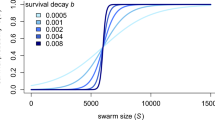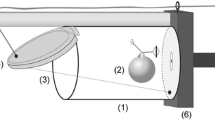Summary
Colonies of eusocial insect species are most vulnerable during the founding stage. Many species have evolved means to minimize the length of the founding, or pre-emergence, stage by accelerating the rate of development of the first worker offspring. Other things being equal, the sooner a colony can begin producing workers, the less the risk of colony failure, the steeper the growth curve of the colony during the ergonomic stage, and the larger the colony will be at reproductive maturity. Swarm-founding species, whose founding units consist of hundreds or thousands of workers, may face less selection pressure to minimize the duration of the founding stage than independent-founding species. However, swarm size varies within species, and small swarms face greater risk of extinction during the founding stage than large swarms. This consideration predicts that within a species, small swarms should have shorter founding stages than large swarms, likely by rearing a small group of precocious brood. On the other hand, evidence that large social groups organize colony labor more efficiently, gather resources more predictably, and homeostatically maintain physical conditions inside the nest within narrower ranges, predicts that larger groups should rear all brood more rapidly and therefore have shorter founding stages. To test whether small or large swarms have shorter founding stages in colonies of Polybia occidentalis, a Neotropical swarm-founding wasp, we measured brood development rates in colonies collected after 28 days of development, just short of the minimum egg-to-adult development time. We found that as size increased across colonies, pre-emergence times decreased, mean age of pupae in the nest increased, and median age of the brood (larvae + pupae) increased. That is, brood developed significantly faster in large colonies than in small ones. Using these same measures, we also found that infection by a gregarine parasite increased brood development time, independently of colony size.
Similar content being viewed by others
Author information
Authors and Affiliations
Corresponding author
Additional information
Received 10 April 2003; revised 29 October 2003; accepted 21 November 2003.
Rights and permissions
About this article
Cite this article
Howard, K.J., Jeanne, R.L. Rates of brood development in a social wasp: effects of colony size and parasite infection. Insect. Soc. 51, 179–185 (2004). https://doi.org/10.1007/s00040-004-0730-8
Issue Date:
DOI: https://doi.org/10.1007/s00040-004-0730-8




